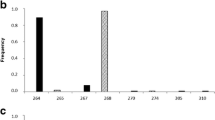Abstract
Alexandrium fundyense is a toxic marine dinoflagellate responsible for “red tide” events in temperate and sub-arctic waters worldwide. In the Gulf of Maine (GOM) and Bay of Fundy in the Northwest Atlantic, blooms of A. fundyense recur annually and are associated with major health and ecosystem impacts. In this region, microsatellite markers have been used to investigate genetic structure and gene flow; however, the loci currently available for this species were isolated from populations from Japan and the North Sea, and only a subset is suitable for the analysis of A. fundyense populations in the Northwest Atlantic. To facilitate future studies of A. fundyense blooms, both in this region and globally, we isolated and characterized 17 polymorphic microsatellite loci from 31 isolates collected from the GOM and from the Nauset Marsh System, an estuary on Cape Cod, Massachusetts, USA. These loci yielded between two and 15 alleles per locus, with an average of 7.1. Gene diversities ranged from 0.297 to 0.952. We then analyzed these same 31 isolates using previously published markers for comparison. We determined the new markers are sufficiently variable and better suited for the investigation of genetic structure, bloom dynamics, and diversity in the Northwest Atlantic.
Similar content being viewed by others
References
Alpermann TJ, John U, Medlin LK, Edwards KJ, Hayes PK, Evans KM (2006) Six new microsatellite markers for the toxic marine dinoflagellate Alexandrium tamarense. Mol Ecol Notes 6:1057–59
Baggesen C, Moestrup Ø, Daugbjerg N, Krock B, Cembella AD, Madsen S (2012) Molecular phylogeny and toxin profiles of Alexandrium tamarense (Lebour) Balech (Dinophyceae) from the west coast of Greenland. Harmful Algae 19:108–16
Benson G (1999) Tandem repeats finder: a program to analyze DNA sequences. Nucleic Acids Res 27:573–580
Dia A, Guillou L, Mauger S, Bigeard E, Marie D, Valero M, Destombe C (2014) Spatiotemporal changes in the genetic diversity of harmful algal blooms caused by the toxic dinoflagellate Alexandrium minutum. Mol Ecol 23:549–60
Dyhrman ST, Erdner D, Du JL, Galac M, Anderson DM (2006) Molecular quantification of toxic Alexandrium fundyense in the Gulf of Maine using real-time PCR. Harmful Algae 5:242–50
Erdner DL, Richlen M, McCauley LAR, Anderson DM (2011) Diversity and dynamics of a widespread bloom of the toxic dinoflagellate Alexandrium fundyense. PLoS One 6:e22965
Excoffier L, Lischer HEL (2010) Arlequin suite ver 3.1.1.3: a new series of programs to perform population genetics analyses under Linux and Windows. Mol Ecol Resour 10:564–67
Gu H, Zeng N, Xie Z, Wang D, Wang W, Yang W (2013) Morphology, phylogeny, and toxicity of Atama complex (Dinophyceae) from the Chukchi Sea. Polar Biol 36:427–36
John U, Litaker RW, Montresor M, Murray S, Brosnahan ML, Anderson DM (2014) Formal revision of the Alexandrium tamarense species complex (Dinophyceae) taxonomy: the introduction of five species with emphasis on molecular-based (rDNA) classification. Protist 165:779–804
Nagai S, Lian C, Hamaguchi M, Matsuyama Y, Itakura S, Hogetsu T (2004) Development of microsatellite markers in the toxic dinoflagellate Alexandrium tamarense (Dinophyceae). Mol Ecol Notes 4:83–85
Nagai S, Lian C, Yamaguchi S, Hamaguchi M, Matsuyama Y, Itakura S, Shimada H, Kaga S, Yamauchi H, Sonda Y, Nishikawa T, Kim CH, Hogetsu T (2007) Microsatellite markers reveal population genetic structure of the toxic dinoflagellate Alexandrium tamarense (Dinophyceae) in Japanese coastal waters. J Phycol 43:43–54
Nagai S, Yasuike M, Nakamura Y, Tahvanainen P, Kremp A (2014) Development of ten microsatellite markers for Alexandrium ostenfeldii, a bloom-forming dinoflagellate producing diverse phycotoxins. J Appl Phycol. doi:10.1007/s10811-014-0500-6
Nakamura Y, Shigenobu Y, Sugaya T, Kurokawa T, Saitoh K (2013) Automated screening and primer design of fish microsatellite DNA loci on pyrosequencing data. Ichthyol Res 60:184–187
Natsuike M, Nagai S, Matsuno K, Saito R, Tsukazaki C, Yamaguchi A, Imai I (2013) Abundance and distribution of toxic Alexandrium tamarense resting cysts in the sediments of the Chukchi Sea and the eastern Bering Sea. Harmful Algae 27:52–59
Richlen ML, Erdner DL, McCauley LAR, Libera K, Anderson DM (2012) Extensive genetic diversity and rapid population differentiation during blooms of Alexandrium fundyense (Dinophyceae) in an isolated salt pond on Cape Cod, MA, USA. Ecol Evol 2:2588–99
Rozen S, Skaletsky HJ (2000) primer3 on the WWW for general users and for biologist programmers. In: Krawetz S, Misener S (eds) Bioinformatics methods and protocols: methods in molecular biology. Humana Press, Totowa, pp 365–86. http://fokker.wi.mit.edu/primer3
Scholin CA, Herzog M, Sogin M, Anderson DM (1994) Identification of group- and strain-specific genetic markers for globally distributed Alexandrium (Dinophyceae) II. Sequence analysis of a fragment of the the LSU rRNA gene. J Phycol 30:999–1011
Schuelke M (2000) An economic method for the fluorescent labeling of PCR fragments. Nat Biotechnol 18:233–34
Tahvanainen P, Alpermann TJ, Figueroa RI, John U, Hakanen P, Nagai S, Blomster J, Kremp A (2012) Patterns of post-glacial genetic differentiation in marginal populations of a marine microalga. PLoS One 7:e53602
Acknowledgments
The authors would like to thank David Kulis and Alexis Fischer for isolating some of the cysts and strains used in this study. Support for this study was provided by the Woods Hole Center for Oceans and Human Health through National Science Foundation (NSF) Grant OCE-1314642, National Institute of Environmental Health Sciences (NIEHS) Grant 1-P01-ES021923-01, and the international collaboration research grant for the Fisheries Research Agency of Japan in 2014.
Author information
Authors and Affiliations
Corresponding author
Rights and permissions
About this article
Cite this article
Sehein, T., Richlen, M.L., Nagai, S. et al. Characterization of 17 new microsatellite markers for the dinoflagellate Alexandrium fundyense (Dinophyceae), a harmful algal bloom species. J Appl Phycol 28, 1677–1681 (2016). https://doi.org/10.1007/s10811-015-0681-7
Received:
Accepted:
Published:
Issue Date:
DOI: https://doi.org/10.1007/s10811-015-0681-7



